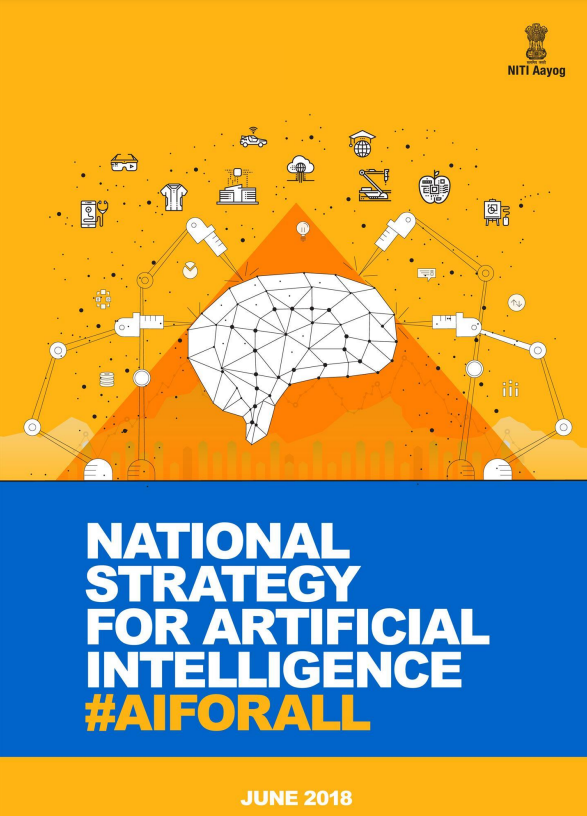Summary of National Strategy for Artificial Intelligence | NITI Aayog India
The document “National Strategy for Artificial Intelligence” consists of several sections. Below is a detailed summary of each section:
1. Introduction
This section sets the context for the National Strategy for Artificial Intelligence (AI) in India. It discusses the global impact of AI and the opportunities it presents for India, emphasizing the need for a strategic approach to leverage AI for economic and social development.
2. Executive Summary
The executive summary provides a brief overview of the key points and recommendations outlined in the strategy. It highlights the focus areas, challenges, and proposed actions to ensure AI contributes positively to India’s growth.
3. What is Artificial Intelligence?
This section explains the concept of AI, its various subfields, and the technological advancements that have enabled its current capabilities. It also differentiates between narrow AI and general AI, emphasizing the practical applications of narrow AI in today’s world.
4. Global Developments in Artificial Intelligence
Here, the document reviews the AI strategies and initiatives of leading countries, analyzing how they are investing in AI research, development, and deployment. It examines the global competitive landscape and the lessons India can learn from these countries.
5. Artificial Intelligence and India
This section assesses India’s position in the global AI landscape. It discusses the country’s strengths, such as a large pool of skilled professionals and a robust IT industry, as well as challenges like data availability and infrastructure limitations. The section also highlights the potential of AI to address societal challenges in India.
6. Focus Areas for AI Intervention
The strategy identifies key sectors where AI can have the most significant impact in India, including:
- Healthcare
- Agriculture
- Education
- Smart Cities and Infrastructure
- Smart Mobility and Transportation
7. Key Challenges to Adoption of AI in India
This section outlines the major obstacles to AI adoption in India, such as:
- Lack of data availability and sharing
- Limited AI expertise and research capabilities
- Ethical, privacy, and security concerns
- Need for robust regulatory frameworks
8. Way Forward to Harness the Power of AI
The document proposes a roadmap for advancing AI in India. It includes recommendations for policy actions, investment in research and development, and collaboration between government, industry, and academia to create an enabling environment for AI.
9. Research
This section emphasizes the importance of AI research and innovation. It suggests creating dedicated AI research centers, increasing funding for AI projects, and fostering collaboration between academic institutions and industry.
10. Skilling for the AI Age
The strategy stresses the need for developing AI-related skills across the workforce. It recommends updating educational curricula, promoting AI literacy, and providing training programs to ensure a steady supply of AI talent.
11. Accelerating Adoption
This section discusses strategies to accelerate the deployment of AI solutions in various sectors. It includes measures to incentivize AI adoption, support startups, and facilitate the development of AI-driven applications.
12. Ethics, Privacy, Security and Artificial Intelligence
The document addresses the ethical considerations and potential risks associated with AI. It underscores the importance of establishing ethical guidelines, ensuring data privacy and security, and promoting transparency in AI systems.
13. Actions for the Government
This section outlines specific actions the government can take to support the AI ecosystem, such as:
– Formulating AI policies and regulations
– Creating infrastructure for AI research and deployment
– Providing financial incentives for AI projects
– Facilitating international cooperation in AI
14. Appendix I: Artificial Intelligence Explained
This appendix provides a detailed explanation of AI technologies, methodologies, and applications, serving as a technical reference for readers.
15. Appendix II: Global Country Strategy Review
This appendix reviews the AI strategies of various countries, highlighting their approaches to AI governance, investment, and development. It offers insights into best practices and strategic priorities from around the world.
16. Appendix III: Data Ecosystem
The final appendix discusses the importance of a robust data ecosystem for AI. It covers data generation, collection, storage, and sharing, emphasizing the need for data standards and policies to support AI innovation.
This summary captures the essence of each section, providing a comprehensive overview of the document’s content.



[…] Must Read: Summary of National Strategy for Artificial Intelligence| NITI Aayog India […]